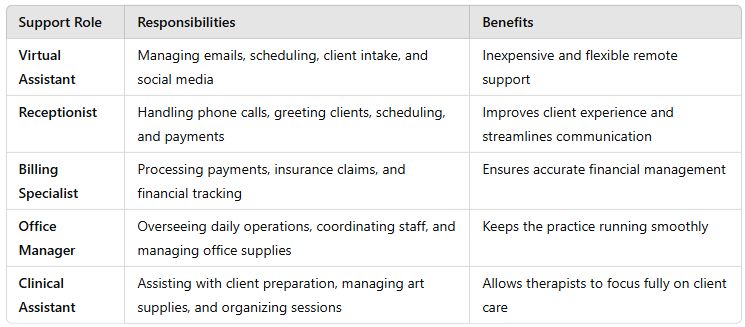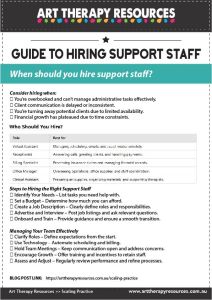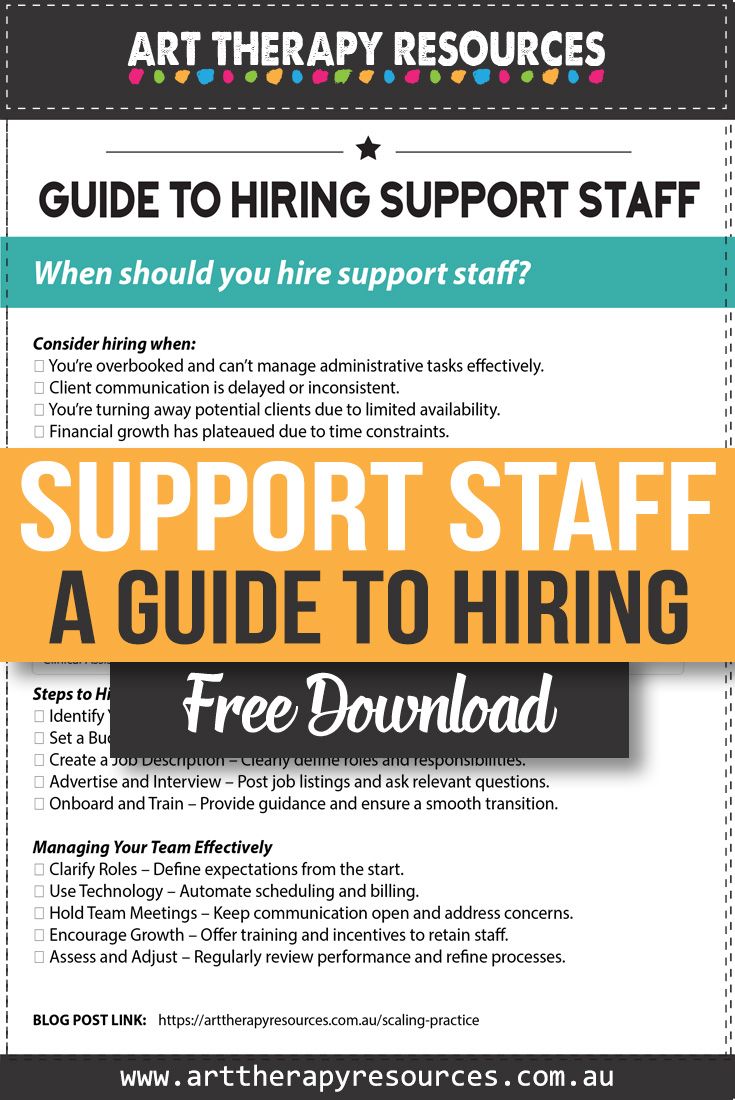THIS POST INCLUDES:
1. When is it time to hire?
2. Types of Support Staff
3. How to Hire
4. Managing and Delegating
4. Free Download Summary to Hiring Support Staff
WHEN IS IT TIME TO HIRE?
As an art therapist in private practice, you dedicate your time to supporting clients in their healing journey through creative expression. However, as your practice grows, managing administrative tasks, scheduling, billing, and client communication can become overwhelming. At a certain point, hiring support staff can help you maintain efficiency, improve client care, and allow you to focus on your core therapeutic work.
Some important areas we will consider in this post include:
- Recognizing When It’s Time to Hire Support Staff – Understanding the signs that indicate you need additional help.
- Types of Support Staff and Their Roles – Exploring different staffing options and how they can enhance your practice.
- How to Hire the Right Support Staff – A step-by-step approach to finding, interviewing, and onboarding employees.
- Managing and Delegating Effectively – Strategies to ensure smooth collaboration and maximize productivity.
Many private practitioners start as solo entrepreneurs, handling every aspect of their business. However, as client demand increases, certain indicators suggest it may be time to bring in additional help:
- Overwhelming Administrative Work – If scheduling, billing, emails, and paperwork consume hours of your day, leaving little time for therapy or personal self-care, an administrative assistant can ease this burden.
- Difficulty Managing Client Inquiries – If you’re turning away potential clients because you’re too busy to schedule or follow up, you may be missing growth opportunities.
- Decreased Work-Life Balance – Working late nights or weekends to keep up with business operations is a sign that you need help.
- Missed or Delayed Payments – If keeping track of invoices and payments is a struggle, hiring a bookkeeper or virtual assistant can ensure financial stability.
- Interest in Expanding Services – If you want to offer workshops, group therapy, or online programs but lack the time to develop them, bringing in additional support can help.
Recognizing these signs early allows you to take proactive steps toward hiring the right team members before burnout or inefficiency affects your practice.
TYPES OF SUPPORT STAFF
Depending on your needs, you may consider hiring different types of support staff, each serving a specific function.
Types of Support Staff: Choosing the Right Help for Your Practice
As your art therapy practice grows, so do the administrative and clinical demands. Hiring support staff can alleviate pressure, streamline operations, and ultimately allow you to focus on providing quality therapeutic care. Understanding the different roles that support staff can play is key to making effective hiring decisions.
a. Administrative Assistants
Primary Role:
Administrative assistants handle essential day-to-day tasks that keep your practice running smoothly. They are often the first point of contact for clients and play a key role in setting a professional, welcoming tone.
Responsibilities Might Include:
- Answering phone calls and emails
- Scheduling and rescheduling appointments
- Managing intake forms and consent documents
- Organizing client files and recordkeeping
- Billing and invoicing
- Handling insurance claims and correspondence
Benefits:
Hiring an administrative assistant can free up several hours a week, allowing you to concentrate on therapy sessions and client care. For solo practitioners, even a part-time assistant can provide significant relief from routine tasks.
b. Billing and Insurance Specialists
Primary Role:
These professionals specialize in managing the financial side of therapy services, particularly billing insurance companies and handling claims.
Responsibilities Might Include:
- Verifying client insurance coverage
- Submitting insurance claims
- Tracking reimbursements and outstanding payments
- Managing client payments and financial records
- Communicating with insurers on denied or delayed claims
Benefits:
Outsourcing billing to a specialist reduces errors, increases cash flow, and minimizes delays. It’s particularly useful for practices accepting multiple insurance plans or serving clients with complex coverage situations.
c. Clinical Support Staff (e.g., Interns or Associate Therapists)
Primary Role:
Licensed associate therapists or supervised interns can expand your clinical offerings under your supervision, allowing your practice to serve more clients without overloading your personal caseload.
Responsibilities Might Include:
- Conducting intake assessments
- Providing individual or group art therapy under supervision
- Assisting with client outreach and program development
- Contributing to treatment planning and documentation
Benefits:
Bringing on associate-level therapists can help scale your services affordably while supporting the growth of emerging professionals in the field. If your caseload is full or if you want to introduce lower-fee options, this is a highly strategic staffing move.
d. Marketing and Communications Help
Primary Role:
These professionals support your practice’s visibility, branding, and communication with current and potential clients.
Responsibilities Might Include:
- Managing your website and social media
- Designing newsletters and client outreach emails
- Creating promotional materials
- Writing and scheduling blog posts or content
- Helping with SEO and digital advertising campaigns
Benefits:
If you want to grow your client base or maintain a consistent online presence, investing in marketing support can be transformative. It allows you to remain engaged with your community without diverting time from clinical work.
e. Virtual Assistants (VAs)
Primary Role:
Virtual assistants offer remote administrative support and can often wear multiple hats, depending on your practice needs.
Responsibilities Might Include:
- Scheduling and reminders
- Client communication
- Data entry and document preparation
- Managing teletherapy platform logistics
Benefits:
VAs are especially helpful for solo practitioners who want flexible, scalable assistance without the overhead of hiring full-time, in-person staff. They’re often ideal for practices with limited office space or a hybrid/in-person/telehealth model.
f. Bookkeepers or Accountants
Primary Role:
These professionals help manage your financial records and ensure you’re operating in compliance with tax regulations.
Responsibilities Might Include:
- Tracking income and expenses
- Reconciling accounts
- Preparing financial reports
- Assisting with tax planning and filing
Benefits:
Hiring a bookkeeper ensures financial clarity and reduces your risk of errors at tax time. A good accountant can also provide insights on profitability and guide your growth strategy.
Tailoring Your Hiring to Your Practice’s Needs
Not every art therapy practice will need all these roles right away. Start by identifying the areas where you feel most overextended.
When you’re just beginning to scale, consider hiring part-time or contract-based help first. You can gradually increase hours or transition to full-time staff as your needs and revenue grow. Think of each staff member not just as an extra pair of hands, but as a long-term investment in the sustainability of your practice.
Assessing which roles would benefit your practice most can help you make an informed hiring decision.

HOW TO HIRE
Hiring support staff requires thoughtful planning to ensure you find the right fit for your practice. Follow these key steps:
Step 1: Identify Your Needs
List all the tasks you need help with and prioritize them. This will clarify whether you need a part-time assistant, a full-time receptionist, or specialized staff like a billing professional.
Step 2: Set a Budget
Determine how much you can afford to spend on hiring. Consider starting with a part-time employee or contractor before committing to full-time staff.
Step 3: Write a Clear Job Description
Outline key responsibilities, required qualifications, and skills. Be specific about expectations and how the role will support your practice.
Step 4: Advertise and Interview Candidates
Post job listings on platforms such as:
– Job sites like Indeed, LinkedIn, or specialized healthcare job boards.
– Local art therapy or mental health associations.
– Word-of-mouth referrals from colleagues.
During interviews, ask questions related to:
– Experience in healthcare or mental health settings.
– Comfort level with confidentiality and ethical considerations.
– Communication skills and ability to handle client interactions.
Step 5: Onboard and Train
Once you’ve selected the right candidate, ensure a smooth onboarding process:
– Provide a handbook or guide outlining procedures and expectations.
– Offer training on scheduling systems, client confidentiality, and office procedures.
– Set up regular check-ins to ensure they are adjusting well.
– Taking the time to hire and onboard properly ensures that your practice benefits from skilled and reliable support.
MANAGING AND DELEGATING EFFECTIVELY
After hiring support staff, maintaining clear communication and proper delegation is essential for long-term success.
Here are some best practices:
Define Roles and Responsibilities Clearly
– Ensure all team members understand their job duties and boundaries to avoid overlap and confusion.
Use Technology to Streamline Workflows
– Implement scheduling software (such as SimplePractice or Acuity) to manage appointments.
– Use secure cloud storage (like Google Drive or Dropbox) for document sharing.
– Utilize billing software to automate invoices and payments.
Hold Regular Team Meetings
– Meet weekly or bi-weekly to review workflow, address concerns, and improve efficiency. This fosters a collaborative environment and helps resolve issues before they escalate.
Encourage Professional Growth
– Support staff retention improves when employees feel valued.
Consider offering:
– Training on HIPAA compliance and client confidentiality.
– Opportunities to learn about art therapy principles to enhance their understanding of the practice.
– Incentives such as flexible work arrangements or small bonuses for outstanding performance.
Evaluate and Adjust as Needed
– Periodically assess whether your support system is effective. Are clients receiving better service? Are administrative tasks being handled efficiently? If necessary, refine staff roles or invest in additional support
FREE DOWNLOAD: Art Therapy Exercise
SIGN UP below to gain access to our RESOURCE LIBRARY and download the FREE Summary Guide to Hiring Support Staff.

BUILD YOUR ART THERAPY REFERENCE MATERIALS:
Pin this image to your Pinterest board.

SHARE KNOWLEDGE & PASS IT ON:
If you’ve enjoyed this post, please share it on Facebook, Twitter, Pinterest. Thank you!
